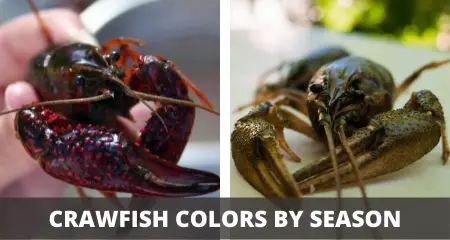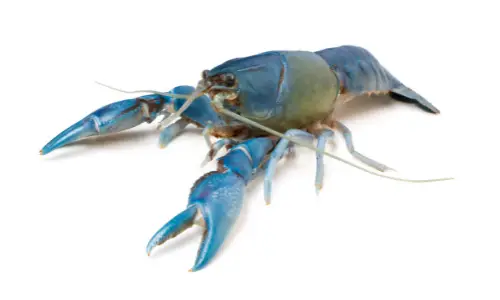Crayfish Color Chart (Seasonal Patterns Explained)
UPDATED 03 NOVEMBER 2023
by Robert Ceran
Are you wondering what color crawfish are throughout the year, so you can choose crawfish lures that match the hatch?
If you’re a bass angler, it’s important to know how the color patterns of your local crawfish population change over the seasons.
This will help you get a better understanding of what crayfish colors bass are looking for at any particular time of the year.

In this article we’ll cover the main crawfish colors by season, and will also explain what causes their color transitions, to help you choose the right color lures for every season.
Freshwater crayfish color chart (by season)
| Season | Image | Most common colors |
|---|---|---|
| Early spring |  | Green pumpkin |
| Late spring |  | Green pumpkin with increasing amounts of orange |
| Early summer |  | Orange |
| Late summer |  | Watermelon red or dark red |
| Fall |  | Dark brown or dark green |
| Winter |  | Black |
The table above shows the most common seasonal colors of freshwater crayfish in North America.
Note that these color transitions occur gradually, and as a result you’ll usually find mixed populations at any specific time.
Once you have a good grasp on how crawfish colors change over the seasons, you can use that to choose the best colors for your fishing lures.
For more details on this, check out our detailed guide on crawfish lures.
Do crawfish change colors?
Yes, crawfish change colors with seasonal patterns, and their color also changes depending on age, maturity, and diet.
In addition to this, it’s also important to keep in mind that there are more than a dozen crawfish species and subspecies living across North America, which means that crayfish colors can be quite diverse from location to location.
Now let’s take a closer look at each of the crawfish colors by season, to understand the main crayfish color transitions that occur over the year.
What color are crawfish throughout the year?
In general, crawfish are green pumpkin in spring, and gradually turn orange and then red as the water warms up to 70-80 degrees. In fall they become dark brown or dark green, and in winter they turn black.
Keep in mind that this is a rough approximation of crawfish color phases over the seasons, and you can usually find a mix of crayfish colors at any specific time of the year, since every crawfish changes colors at a different rate.
In addition to this, you also need to factor in that juvenile crayfish are a different color than adults (mostly green pumpkin), and that older crawfish tend to get darker over time.
What time of the year do crawfish turn red?
Crawfish turn red in the summer, when the water temperature is above 70-80 degrees.
However, there are also some species of crawfish that burrow into clay during the winter months, and when they emerge from their burrows in spring, they are already orange or red, due to their diet in the burrows.
Why do crawfish turn red?
The reason why crawfish turn red is that they get more vitamin A in their diet as the water warms up, and this causes them to gradually turn orange in early summer, and then watermelon red, and finally dark red at the peak of summer.
Crawfish color in spring
In early spring, crawfish are predominantly pumpkin green with a pearl white underside.
They can also have some brown patches, and as the water warms up in late spring, they start to get more and more orange color patches in their exoskeleton.
Crawfish color in summer
In early summer, crawfish are predominantly bright orange, and then turn watermelon red or dark red at the peak of summer.
This color change is due to their diet at this time of the year, which includes increasing amounts of vitamin A.
Crawfish feed mostly on zooplankton which they scrape off rocks and vegetation, and at the peak of summer they ingest a lot of plant cells in addition to the zooplankton, which is high in vitamin A.
Crawfish color in fall
As the water cools down in fall, crawfish lose their red color, and turn dark brown or dark green instead.
Since this occurs gradually, you can still find crawfish that have some reddish or purple patches, but these gradually get less during the progression from early to late fall.
Crawfish color in winter
In winter, crawfish mostly turn very dark, and can be either black or dark brown. At this time of the year they burrow underground, and don’t re-emerge until spring, when the water temperature reaches 50 degrees.
What determines crayfish color?
Crayfish color is determined by several factors, including diet, age, maturity, and water temperature.
In general, juvenile crawfish are green pumpkin colored, while mature crawfish tend to be black or dark brown during the winter months, and turn orange and red during the summer months.
Over the course of the year, the amount of orange and red pigmentation of crawfish changes according to what they eat at different times of the year.
As the water warms up in spring, they ingest more and more vitamin A, and this causes them to turn first orange, and then red.
When do crawfish come out of hibernation?
Crawfish come out of their winter burrows when the water temperature reaches about 50 degrees, which can be as early as February in southern latitudes, and as late as May in northern ones.
When crawfish emerge in early spring, they immediately start to mate, and at this time of the year male crawfish fearlessly strut around on top of rocks in search of receptive females.
This behavior makes crawfish vulnerable to being eaten by bass in spring, which hunt crawfish as their main forage at this time of the year.
The fact that bass are keyed in to eating crawfish in early spring is the main reason why using crawfish lures is so effective at this time.
When do crawfish spawn?
Red swamp crawfish can spawn throughout the year in southern parts of their range, while other crawfish species, such as the white river crawfish, spawn mostly in autumn.
It’s important to note that mating and spawning don’t co-occur at the same time in crawfish. This is because female crawfish can store the sperm of the males, and don’t fertilize their eggs until they are ready to do so.
For bass fishing, crawfish spawning is not as important as their mating, since crawfish mating behavior makes them vulnerable to bass, and as a result of this bass are keyed in on crawfish during this time.
Crawfish have two main mating phases during the year, one during early spring, and one during early fall, which are both prime times to throw crawfish lures for bass.
Fishing lures with crawfish color patterns
The three main types of fishing lures that are designed to resemble crawfish are crankbait craws, soft plastic craws, and crawfish jigs.
Crankbaits that look like crawfish are an excellent choice during spring, as bass actively feed on crawfish at this time of the year, and you can bounce them off rocks or tree stumps, which closely mimics the behavior of crawfish.
Soft plastic craws can be fished many different ways, but the most popular option is to use them as a trailer on a skirted jig.
Since a jig can be hopped along the bottom, this setup is also great at imitating the behavior of a real crawfish.
Choosing crawfish colors for bass
A great way to choose the best crawfish colors for bass is to match the hatch, by throwing crawfish lures that have colors closely resembling the color of crayfish in your lake at that season.
However, there is another school of thought that says you don’t really need to match the hatch with your crawfish lure, and that it’s actually better to use a different color, since that allows your lure to stand out from everything else.
This second approach is supported by experiments in which anglers added food coloring to live crawfish, and found that the colored crawfish caught more bass than regular ones.
In other words, you should always experiment with different colors to figure out what the bass want, and don’t just assume you have to stick to the natural crawfish colors.
Personally, I always start by matching the hatch, and if I don’t get any bites, mix up the colors.
Blue crawfish
While many crawfish species have some blue hues in their exoskeleton during winter and spring, most of them are not completely blue at any time of the year.
However, there is a blue crayfish species in the USA, which (as suggested by its name) its completely blue. The blue crayfish is endemic to Florida (see photo below).

This underscores the fact that there are many different crawfish species and subspecies, so you should always make sure to check the color of your local crawdad population if you want to match the hatch.
The easiest way to figure out what color crawfish are in your lake is to set up traps close to boat ramps, and bait them with cat food.
Some bass pros like to set up crawfish traps before any major tournaments in spring and fall, in order to figure out what color the crayfish are before choosing their lures.


